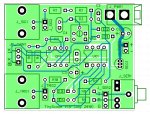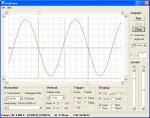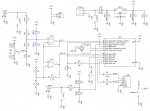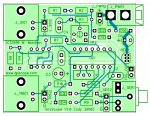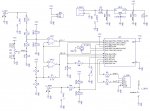Hi all,
as for sure many of you are aware by now, I like building test equipment including oscilloscopes. See the Picaxe scope at http://www.pdamusician.com/lcscope or the dsPIC oscilloscope at http://www.dpscope.com
Right now I am playing with a much simpler design - not Picaxe based (I tried for quite a while but there just seems to be now way to get stable enough timing) but rather a PIC12F683 (same chip as the Picaxe 08M). Again it's a PC based scope. Preliminary schematic and board layout are attached to this post.
The idea is to minimize component count and cost while retaining a very simple-to-build design (e.g. no fine-pitch or surface mount components). It still has a frontend with input protection (large resistor, clamping diodes) and selectable gain/attenuation; input impedance is 1 MOhm so it can use any standard scope probe if desired (but works with just jumper cables as well - the BNC connectors are optional). Connection to the PC is through a serial cable with phono connector, so you could use the Picaxe download cable - further reducing cost. There is only a single channel, but it has a separate trigger input (for TTL/CMS signals, i.e. 0-5V) so you can trigger either on the measured signal or on a separate trigger.
A basic prototype is already up and running on my desk. The PC software is also about 80% done. It should be able to do single-shot capture up to ~5000 samples/sec, and equivalent time sampling (for repetitive waveforms) up to 1 MSa/sec. That's good enough to look at signals up to ~100 kHz, so you could look e.g. at serial data strems, PWM, etc.
I am planning to make it an open design - i.e. schematic and firmware (HEX file and C source code) as well as the PC program freely available, so anybody can build his/her own. I estimate total component cost to be US$10 - US$30 for a one-off built on a stipboard, depending on what you already have in your drawer and what options you want (e.g. BNC connectors or none, and external power supply vs. 9V battery).
In addition I may also offer a pre-prgrammed microcontroller and the printed circuit board for people who e.g. don't have a PIC programmer or want a more professional looking board, but nobody will be forced to got that route. Still I'd like to hear how much interest there would be for that to judge if it is worth doing.
Wolfgang
as for sure many of you are aware by now, I like building test equipment including oscilloscopes. See the Picaxe scope at http://www.pdamusician.com/lcscope or the dsPIC oscilloscope at http://www.dpscope.com
Right now I am playing with a much simpler design - not Picaxe based (I tried for quite a while but there just seems to be now way to get stable enough timing) but rather a PIC12F683 (same chip as the Picaxe 08M). Again it's a PC based scope. Preliminary schematic and board layout are attached to this post.
The idea is to minimize component count and cost while retaining a very simple-to-build design (e.g. no fine-pitch or surface mount components). It still has a frontend with input protection (large resistor, clamping diodes) and selectable gain/attenuation; input impedance is 1 MOhm so it can use any standard scope probe if desired (but works with just jumper cables as well - the BNC connectors are optional). Connection to the PC is through a serial cable with phono connector, so you could use the Picaxe download cable - further reducing cost. There is only a single channel, but it has a separate trigger input (for TTL/CMS signals, i.e. 0-5V) so you can trigger either on the measured signal or on a separate trigger.
A basic prototype is already up and running on my desk. The PC software is also about 80% done. It should be able to do single-shot capture up to ~5000 samples/sec, and equivalent time sampling (for repetitive waveforms) up to 1 MSa/sec. That's good enough to look at signals up to ~100 kHz, so you could look e.g. at serial data strems, PWM, etc.
I am planning to make it an open design - i.e. schematic and firmware (HEX file and C source code) as well as the PC program freely available, so anybody can build his/her own. I estimate total component cost to be US$10 - US$30 for a one-off built on a stipboard, depending on what you already have in your drawer and what options you want (e.g. BNC connectors or none, and external power supply vs. 9V battery).
In addition I may also offer a pre-prgrammed microcontroller and the printed circuit board for people who e.g. don't have a PIC programmer or want a more professional looking board, but nobody will be forced to got that route. Still I'd like to hear how much interest there would be for that to judge if it is worth doing.
Wolfgang
Attachments
-
128.3 KB Views: 315
-
130.2 KB Views: 246
Last edited:


